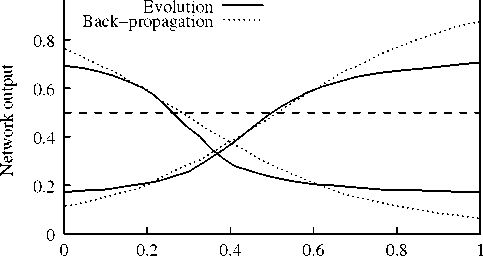1

Intensity
Figure 5: Intensity generalization profiles for networks trained with an evolutionary algo-
rithm and a back-propagation one. The training stimuli, labelled by the intensity of the
signal, are shown. The target outputs were 0.2 for S- and 0.6 for S+. The horizontal line
is the response from an untrained network.
4.2 The Translation Test
Experimentally, generalization gradients obtained with test stimuli that are a rear-
rangement of the training ones (as explained in ‘Testing the Model’ above) give
very different results from intensity generalization tests. A typical example, rel-
ative to wavelength discrimination in pigeons, is given in figure 6, taken form
Hanson (1959). We focus first on the control subjects (solid line in the figure),
that were trained to peck at a key when it was illuminated with a coloured light
and not to respond to the dark key. During the generalization test the wavelength
of the light was changed, and the resulting gradient has a maximum located at S+ ,
with response decreasing as the test stimulus grows different from the training
one.
More generally, the shape of the control gradient in figure 6 is representative
of all studies in which, following interdimensional training, the test stimuli are in
some way a rearrangement of the training ones (Kalish & Guttman 1959; Jenkins
& Harrison 1960, 1962; Marsh 1972; Purtle 1973) although the ways by which
rearrangement can be achieved are many (for example, by tilting a line or changing
the frequency of a tone mantaining its intensity constant). Theoretical arguments
(Ghirlanda & Enquist, unpublished data), as well as the cited empirical evidence,
support this conclusion.
The other gradients in figure 6 come from groups of pigeons that, after a pre-
training identical to that of the control group, were given discrimination training
in which S- was a light differing in wavelength from S+ . These gradients have a
similar shape to the control one, but their peaks are shifted from S+ in the direc-
tion away from S- (the height difference between the postdiscrimination gradients
More intriguing information
1. Cultural Diversity and Human Rights: a propos of a minority educational reform2. CONSUMER PERCEPTION ON ALTERNATIVE POULTRY
3. Chebyshev polynomial approximation to approximate partial differential equations
4. The InnoRegio-program: a new way to promote regional innovation networks - empirical results of the complementary research -
5. Ex post analysis of the regional impacts of major infrastructure: the Channel Tunnel 10 years on.
6. Managing Human Resources in Higher Education: The Implications of a Diversifying Workforce
7. DURABLE CONSUMPTION AS A STATUS GOOD: A STUDY OF NEOCLASSICAL CASES
8. Housing Market in Malaga: An Application of the Hedonic Methodology
9. THE UNCERTAIN FUTURE OF THE MEXICAN MARKET FOR U.S. COTTON: IMPACT OF THE ELIMINATION OF TEXTILE AND CLOTHING QUOTAS
10. The Impact of Individual Investment Behavior for Retirement Welfare: Evidence from the United States and Germany